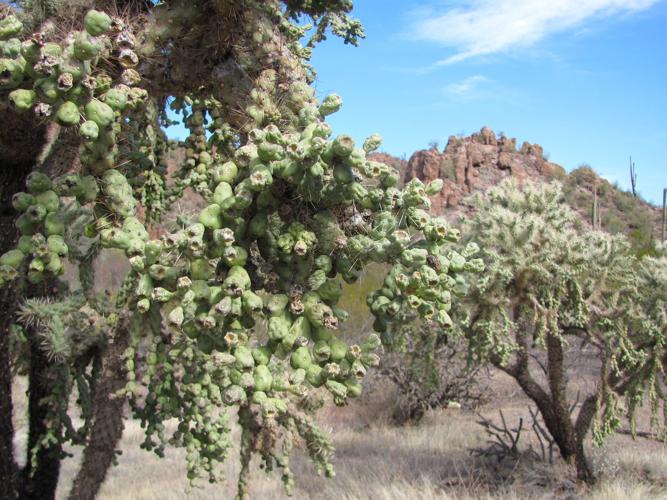Spend any amount of time out in the desert, and chances are you've encountered a jumping cholla.
It happens to the best of us.
The cylindropuntia fulgida, AKA chain-fruit or jumping cholla, has a reputation for being a real pain. Brush by one of these guys, and you're sure to get stuck with barbed spines clinging to your clothing or skin.
So just plan on admiring from afar (because we do think they're worth admiring).
Here are three reasons why.
1. They're just trying to survive in this crazy world

Jumping cholla further increase their reproducing potential by hitching a ride on passing people or animals.
First of all, jumping cholla don't actually jump.
Instead, they just have super sharp spines with a lot of barbs that easily detach from the parent plant and onto the nearby victim ... er ... passerby. They do this to reproduce.
People are also reading…
Also, they're CLONES! Sort of.
Because they're able to detach, root and then grow into a large cactus, often within close proximity to one another, jumping cholla often grow in "clonal colonies" according to the Arizona-Sonora Desert Museum.
Jumping cholla can root in the ground right where they fall, so really, by attaching to your shoelace, they're just trying to share the cholla love. That's why they latch onto passersby — to cover more ground.
So even when you pry those painful spines from your skin or clothing and toss the cholla joint to the ground, you've just planted a cholla in a new location, according to this Arizona Daily Star story.
Mission accomplished.
Fallen fruit can also sprout new plants. These spineless fruit chains can grow quite long over the years, with some fruit hanging on for more than 20 years, according to the "Field Guide to Cacti and Other Succulents of Arizona."
2. They're actually quite beautiful

Jumping cholla cactus.
If you've ever seen a backlit cholla, you know what we're talking about. The spines — about half an inch to more than an inch in length — are usually silver or gold. Which means at sunset, those cholla look like they're covered in pixie dust.
According to the field guide, the second word in their name — fulgida — comes from the word fulgid or fulgent, which means "bright and shining." And that's English, by the way.
Jumping cholla can get large, with the potential to grow more than 12 feet in height and 8 feet in width. From May through August, small, pink flowers adorn the cholla, adding a dainty touch to an otherwise fierce looking cactus.
3. Their strategy appears to be working

A chain fruit cholla, also known as a jumping cholla, at Saguaro National Park west of Tucson. Chains can have 10 to 12 fruits.
You'll find jumping cholla all over Southern Arizona, especially in the Tucson area, and down into Mexico. They grow in the sandy soil of washes and on hillsides and grasslands, according to the guide. It might be hard to believe, but their prevalence is actually a good thing. The cholla play an integral role in the ecosystem. Animals eat their fruit and find shelter among their stems.
So like we said, admire from afar.
If you do happen to find one mysteriously attached to you, wedge a comb between you and the cholla to yank it away. Here are some tips for getting free.
Sources: "Field Guide to Cacti and Other Succulents of Arizona" by Peter Breslin, Rob Romero, Greg Starr and Vonn Watkins; "Admire the jumping cholla cactus, but beware of its tricks" in the Arizona Daily Star March 1, 2018; "Genus Opuntia" by the Arizona-Sonora Desert Museum












